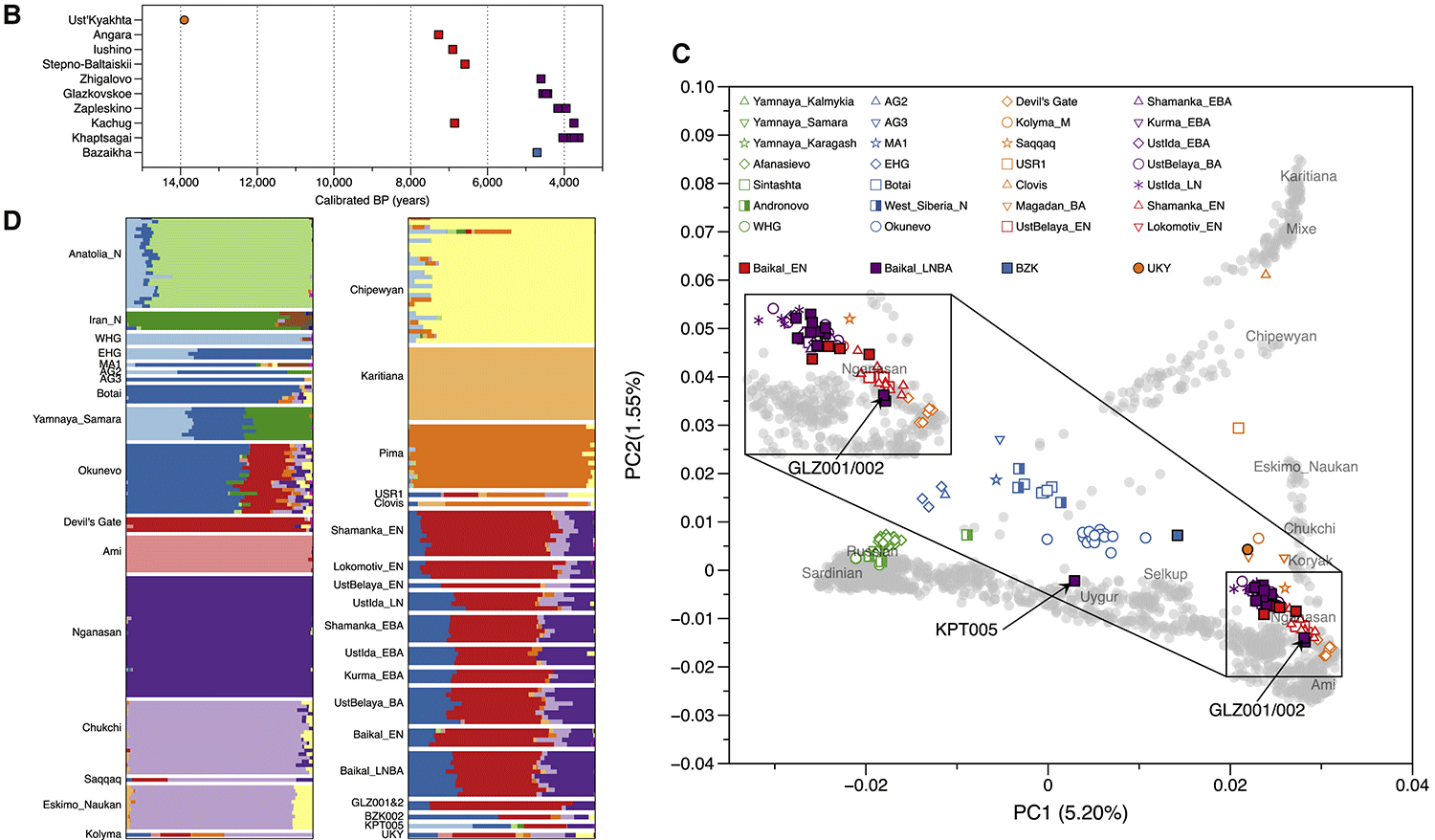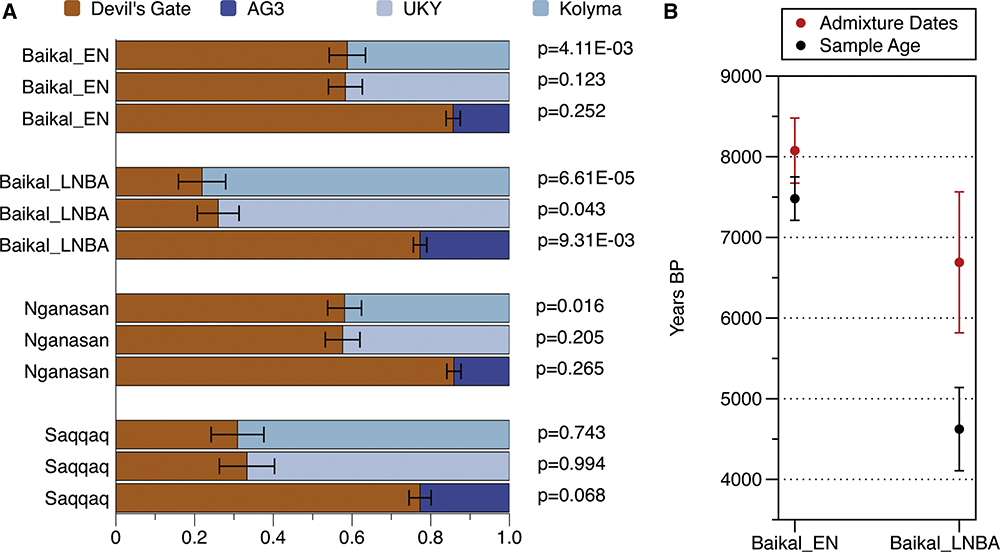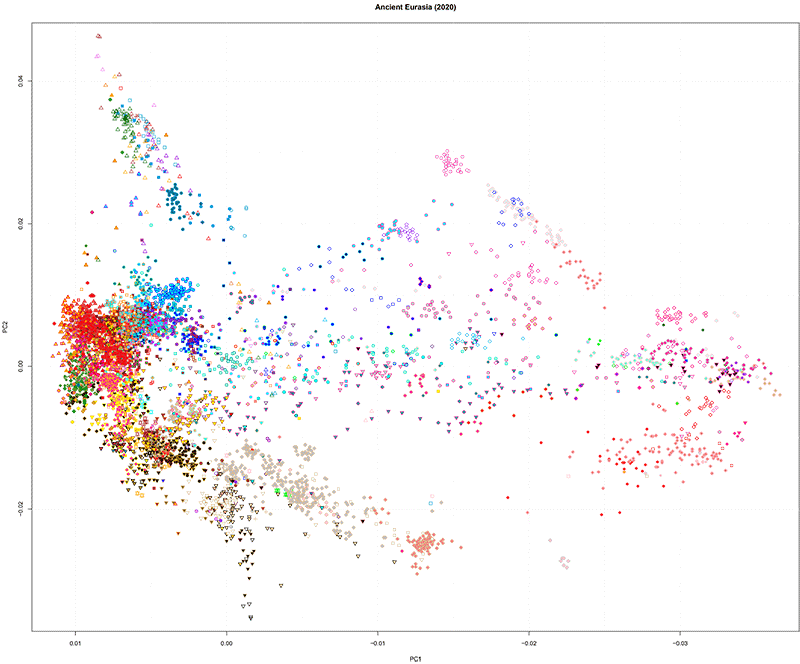New paper (behind paywall) Paleolithic to Bronze Age Siberians Reveal Connections with First Americans and across Eurasia, by Yu et al. Cell (2020)
Interesting excerpts (emphasis mine, paragraphs subdivided for clarity):
Population Structure (PCA)
Most of the Lake Baikal individuals occupied the space on a “ANE-NEA” cline running between “Northeast Asian” (NEA) ancestry represented by Neolithic hunter-gathers from the Devil’s Gate in the Russian Far East (Sikora et al., 2019, Siska et al., 2017), and the ANE ancestry represented by Upper Paleolithic Siberian individuals MA1, AfontovaGora 2 (AG2), and AfontovaGora 3 (AG3) (Fu et al., 2016, Raghavan et al., 2014a), which was first described by Damgaard et al. (2018a).
Our newly sequenced Upper Paleolithic genome from the Ust-Kyakhta-3 site (UKY) just south to the Lake Baikal is placed close to the Mesolithic northeastern Siberian Kolyma individual (Sikora et al., 2019) and is shifted toward Native American populations compared to the rest of the ancient Baikal individuals along PC2.
All four Early Neolithic individuals cluster with published Early Neolithic groups from the same region (Shamanka_EN, Lokomotiv_EN, UstBelaya_EN) (Damgaard et al., 2018a, Flegontov et al., 2019) designated as the “Baikal_EN” population.

(B) Ages of newly reported individuals from each site, with the x axis showing the median calibrated radiocarbon dates after correction for freshwater reservoir effect.
(C) PCA of Eurasian and Native American populations. The modern individuals are shown in light gray circles, with the name of several representative populations marking the positions of West Eurasians (Sardinian), East Asians (Ami and Uyghur), Siberians (Chukchi, Eskimo Naukan, Koryak, Nganasan, Selkup), and Native Americans (Chipewyan, Mixe, Karitiana). Ancient individuals are shown in colored symbols. The individual KPT005, which showed a significant shift toward west Eurasian populations, and individuals GLZ001&GLZ002, which also represented outlier genetic profiles, are marked out with an arrow.
(D) Population clustering pattern of studied individuals together with representative modern and ancient populations, when K = 16. Most Early Neolithic to Bronze Age Lake Baikal region individuals are modeled as admixture of northeast Asian (dark red), ANE (dark blue), and Nganasan component (purple). The BZK002 individual has similar genetic profile as Okunevo, with a significantly larger ANE proportion compared with Baikal individuals, while the KPT005 individual shows a large component associated to WHG (light blue).
The LNBA individuals were divided into four groups.
- The major “Baikal_LNBA” group included 10 individuals and clustered with published Late Neolithic to Bronze Age Baikal populations (Shamanka_EBA, Kurma_EBA, UstIda_EBA, UstIda_LN, UstBelaya_BA). These individuals were positioned in PCA closer to ANE-related individuals compared with the Early Neolithic individuals from the same region, as well as closer to the Paleo-Eskimo Saqqaq individual (Rasmussen et al., 2010).
- Another two individuals (GLZ001 and GLZ002) from the Glazkovskoe predmestie site, unlike the third individual from the same archaeological site (GLZ003), seemed shifted from the main cluster and showed closer genetic affinity to the Devil’s Gate and Early Neolithic Baikal individuals.
- One of the six individuals from the Kachug site (KPT005) was substantially displaced from the Baikal_LNBA group toward western Eurasians along PC1, not along the ANE-NEA cline but toward later Bronze Age populations, suggesting a potential introgression of the Steppe-related ancestry.
- Finally, an Early Bronze Age individual (BZK002) from the Bazaikha site in the Yenisei River region further to the west of the Lake Baikal was significantly displaced toward ANE-related individuals and located close to published Bronze Age individuals associated to the Okunevo culture (Damgaard et al., 2018a).
Complex Transition between the Early Neolithic and Bronze Age
Using Devil’s Gate as the NEA proxy, the Upper Paleolithic UKY was found to be a better fit than Kolyma as the ANE-related proxy for both Baikal populations, while AG3 provided a good fit for the Early Neolithic population.
Using Devil’s Gate and AG3 as the two proxies of NEA and ANE ancestries, respectively, we estimated the ANE-related ancestry increasing from 14.3% in the Early Neolithic Baikal population to 22.7% in the LNBA population.
Of note, the northeastern Siberian Kolyma individual could work as a sufficient ANE proxy for Saqqaq, as described in the study where this genome was first reported (Sikora et al., 2019) but did not provide a good fit for the Baikal populations and Nganasan. This suggests that the Baikal hunter-gatherer and Nganasan populations are more likely to have formed in central or southern Siberia while Paleo-Eskimo ancestry could have emerged in either central or northeastern Siberia.

(A) qpAdm modeling of Early Neolithic and LNBA Baikal populations, together with Nganasan and Saqqaq, as admixture between NEA ancestry represented by Devil’s Gate and different ANE ancestries. The error bars show the standard errors of estimated ancestry proportions. Details for the modeling are provided in Table S3.
(B) Estimated dates of admixture events between ANE and NEA ancestries in Early Neolithic and LNBA Baikal population. The individual ages are the averages and standard deviations of median radiocarbon dates without correcting for freshwater reservoir effect, to be consistent with previously published individuals. The estimated admixture dates are calculated with generation time of 29 years, and the error bars show the sum of standard errors of DATES estimations and individual ages.”
Dating the admixture
Assuming a dating offset of 400–500 years due to freshwater reservoir effect estimated for the newly reported individuals, the admixture timings ranged between ∼8,000 and 5,500 BP. This suggests that both Baikal populations could have been formed through an extended admixture process between local groups and northeast Asian-related populations.
The Early Neolithic groups were thus found to have experienced a prolonged admixture process, in contrast to the discrete and rather abrupt event suggested earlier (Damgaard et al., 2018a).
This admixture, however, did not continue substantially in the Late Neolithic and Bronze Age, as suggested by the older admixture date for the LNBA population (Figure 3B) and the relatively larger genetic variation among Early Neolithic individuals compared to the homogeneous LNBA cluster, as shown in the PCA plot.
Baikal Outliers
The genetic profile of the KPT005 individual suggested its affinity to western Eurasian populations inferred from PCA and ADMIXTURE results. Using qpAdm modeling, we found that this individual could indeed be modeled as the mixture between the LNBA Baikal and multiple Bronze Age western steppe populations, with the Steppe ancestry contribution ranging between 42% and 48%. Considering geography and radiocarbon dates, we suggest the most likely candidate in our dataset for the source of admixture to be the Yamnaya-related Afanasievo population from nearby Altai-Sayan region.
Additionally, we also identified two Early Bronze Age Baikal individuals (GLZ001 and GLZ002) showing significantly lower ANE admixture levels compared to the major Baikal_LNBA group. We estimated the ANE contribution in these two individuals to be around 10%, using Devil’s Gate and AG3 as proxies of NEA and ANE ancestries, respectively. Furthermore, these two individuals both carried Y chromosome haplogroup C2b1, which was predominant in Early Neolithic Baikal populations, while the other LNBA individuals carried exclusively Q1a haplogroup.

Comments
It is a little surprising to find out that Afanasievo-related peoples reached up (or close) to Lake Baikal, well before the Steppe_MLBA-related expansions. The 40-50% Afanasievo ancestry of the early KPT005 (dated ca. 2192-2030 calBC) leaves little doubt about the origin of its Steppe-related ancestry, and probably helps refine the Bronze Age Pre-Tocharian – Pre-Yeniseic – Pre-Samoyedic interaction in the area, as I recently explained regarding Munkh-Khairkhan UAA001, another Bronze Age sample with Afanasievo-related ancestry from Mongolia.
Also interesting are the variable ancestry and PCA cluster displayed by those outliers, hilighting many new potential clines that might have been created not only during these early ANE-NEA admixture events, but especially after the wide-ranging population expansions of the Early Bronze Age, including Late Repin-related migrations.
The sample is still not uploaded to ENA, but I think it will be relevant whether its reported Q1b-L56 lineage is of the same subclade as Okunevo Q1b(-pre)-L54 > L330 and their subclades, also found later among some Mongolia MLBA cultures.
(1) The resurgence events shown by GLZ001 & GLZ002 in this paper and by the Ulgii EBA community in the recent papers on Mongolia, (2) the lack of a fitting ancestral population for North Siberian peoples such as Nganasans among the many sampled ancient groups, as well as (3) the gradual unveiling of a clearer picture of the complex Central and North Siberia-related ancestries, all give a whole new perspective to the many simplistic assessments of ethnolinguistic origins available until now.
NOTE. Despite this, the previous paper by Jeong et al. (2018) with their different admixture values reported for ancient and modern populations seems to have been spot on in revealing the complexity of the multiple Corded Ware-related clines formed by Uralic-speaking peoples across North Eurasia.
In the meantime, here is an updated Eurasian PCA with the newly reported samples (you can also check all PCAs by period and with labels):

Related
- R1b-rich Proto-Indo-Europeans show genetic continuity in Asia
- Samoyedic shows Yeniseic substrate; both influenced Tocharian
- Proto-Tocharians: From Afanasievo to the Tarim Basin through the Tian Shan
- Yamnaya replaced Europeans, but admixed heavily as they spread to Asia
- Iron Age Tocharians of Yamnaya ancestry from Afanasevo show hg. R1b-M269 and Q1a1
- Intense but irregular NWIE and Indo-Iranian contacts show Uralic disintegrated in the West
- Corded Ware ancestry in North Eurasia and the Uralic expansion
- Uralic speakers formed clines of Corded Ware ancestry with WHG:ANE populations
- Bronze Age cultures in the Tarim Basin and the elusive Proto-Tocharians